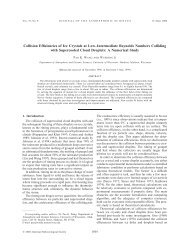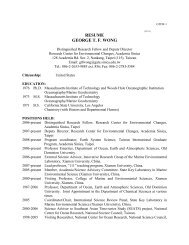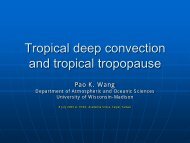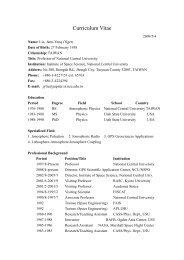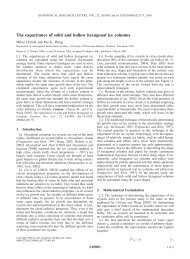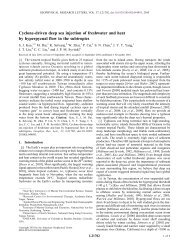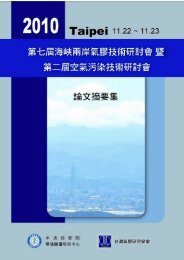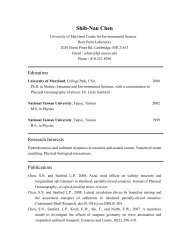Collection of Aerosol Particles by a Conducting Sphere in an ...
Collection of Aerosol Particles by a Conducting Sphere in an ...
Collection of Aerosol Particles by a Conducting Sphere in an ...
- No tags were found...
Create successful ePaper yourself
Turn your PDF publications into a flip-book with our unique Google optimized e-Paper software.
<strong>Collection</strong> <strong>of</strong> <strong>Aerosol</strong> <strong>Particles</strong> <strong>by</strong> a <strong>Conduct<strong>in</strong>g</strong> <strong>Sphere</strong> <strong>in</strong> <strong>an</strong> ExternalElectric Field-Cont<strong>in</strong>uum Regime ApproximationPAO-KUANWANGDepartment <strong>of</strong> Meteorology, University <strong>of</strong> Wiscons<strong>in</strong>, Madison, Wiscons<strong>in</strong> 53706Received J<strong>an</strong>uary 4, 1982; accepted December 13, 1982The collection <strong>of</strong> charged aerosol particles <strong>by</strong> a charged conduct<strong>in</strong>g sphere <strong>in</strong> a uniform electricfield is theoretically <strong>in</strong>vestigated. Cont<strong>in</strong>uum regime is considered <strong>an</strong>d particle concentration is assumedto be described <strong>by</strong> the convective diffusion equation. Analytical solutions satisfy<strong>in</strong>g boundaryconditions for different regions are obta<strong>in</strong>ed. These solutions <strong>in</strong>clude the simult<strong>an</strong>eous effects <strong>of</strong>Browni<strong>an</strong> motion, static charges, <strong>an</strong>d external electric field. Some numerical results are presented.It is also shown that these solutions c<strong>an</strong> be reduced to various limit<strong>in</strong>g cases where some effects areabsent.INTRODUCTIONThe collision <strong>an</strong>d coagulation process <strong>of</strong>aerosol particles has long been <strong>an</strong> import<strong>an</strong>tproblem <strong>in</strong> colloidal science. It has applications<strong>in</strong> both atmospheric sciences <strong>an</strong>d eng<strong>in</strong>eer<strong>in</strong>g.In the atmosphere, for example,the collection mech<strong>an</strong>ism plays <strong>an</strong> import<strong>an</strong>trole <strong>in</strong> the scaveng<strong>in</strong>g <strong>of</strong> aerosol particles.This mech<strong>an</strong>ism has recently received considerableattention (l-lo). In problems <strong>of</strong>chemical eng<strong>in</strong>eer<strong>in</strong>g particle coagulation is<strong>of</strong> import<strong>an</strong>ce as it determ<strong>in</strong>es to a considerableextent the size distribution <strong>an</strong>d thusthe reaction rate <strong>of</strong> the react<strong>an</strong>ts.In this paper we w<strong>an</strong>t to <strong>in</strong>vestigate thecollection process <strong>of</strong> aerosol particles <strong>by</strong> aspherical collector <strong>in</strong> the cont<strong>in</strong>uum regime.The concentration <strong>of</strong> particles is assumed tobe described <strong>by</strong> the convective diffusionequation s<strong>in</strong>ce the particles <strong>in</strong>volved move<strong>by</strong> Browni<strong>an</strong> diffusion while simult<strong>an</strong>eouslyunder the <strong>in</strong>fluence <strong>of</strong> convective forces suchas gravity, hydrodynamic forces, <strong>an</strong>d possiblyphoretic <strong>an</strong>d electric forces. In this studywe shall consider the case where the externalforces <strong>in</strong>volved are electric forces.PHYSICS AND MATHEMATICS1. The convective d$ikon <strong>of</strong> aerosol particlesaround <strong>an</strong> absorb<strong>in</strong>g sphere <strong>in</strong> conservativeforce fields. In this section we willbriefly describe the general formulation <strong>of</strong>the convective diffusion <strong>of</strong> small particles <strong>in</strong>the presence <strong>of</strong> conservative force fieldswhich will be used later. Consider a cloud <strong>of</strong>monodispersed aerosol particles around aperfect absorb<strong>in</strong>g sphere under the <strong>in</strong>fluence<strong>of</strong> a net conservative force field F. Then <strong>by</strong>the def<strong>in</strong>ition <strong>of</strong> conservativeness,orVXF=O[IIF = -VV,PIi.e., it is possible, <strong>in</strong> this case, to f<strong>in</strong>d a scalarpotential function V whose gradient will givethe force.We further assume that this potential functionsatisfies the Laplace equation, i.e.,v2v = 0. [31Equation [3] is satisfied <strong>by</strong> m<strong>an</strong>y force fieldssuch as those <strong>in</strong>volved <strong>in</strong> the irrotational flow<strong>of</strong> a perfect fluid, surface waves, electromagneticphenomena, <strong>an</strong>d gravitation.Journal <strong>of</strong>colloid <strong>an</strong>d Inkyface Science, Vol. 94, No. 2, August 19833010021-9797183 $3.00Copyright 0 1983 <strong>by</strong> Academic Press, Inc.All rights <strong>of</strong> reproduction <strong>in</strong> <strong>an</strong>y form reserved
2.302 PAO-KUAN WANGIf we assume steady-state condition, then+++++++the convective diffision equation for parti----cles exposed the above force field is (12)DV2n-BF.Vn=O, [41where n is the concentration, D the diffusivity,<strong>an</strong>d B the mobility <strong>of</strong> the particles, re-I-:COLLECTORspectively. Accord<strong>in</strong>g to Eq. [2], Eq. [4] c<strong>an</strong>---be rewritten as:v2n+~vv.vn=0.153The general solution <strong>of</strong> Eq. [5] isAEROSOLFlPARTICLEwhere C1 <strong>an</strong>d C, are arbitrary const<strong>an</strong>ts tobe fixed <strong>by</strong> boundary conditions. One simplyhas to substitute Eq. [6] <strong>in</strong>to Eq. [5] to seethat it is <strong>in</strong>deed a solution <strong>of</strong> Eq. [5]. Bysuitable tr<strong>an</strong>sformation <strong>of</strong> Eqs. [5] <strong>an</strong>d [6],one c<strong>an</strong> obta<strong>in</strong> other related equations <strong>an</strong>dtheir solutions (see Appendix A).Note that the above derivations were carriedout <strong>by</strong> vector operations. Thus they arevalid not only for spherical coord<strong>in</strong>ates butfor other coord<strong>in</strong>ates as well. In fact, the applications<strong>of</strong> Eqs. [5] <strong>an</strong>d [6] had been made<strong>by</strong> (13) for cyl<strong>in</strong>drical coord<strong>in</strong>ates <strong>an</strong>d <strong>by</strong>(14) for oblate spherical coord<strong>in</strong>ates. Notealso that the force fields which satisfy theabove derivations need not to be radiallysymmetrical.2. Distribution <strong>of</strong> aerosol particles arounda spherical conductor under the <strong>in</strong>fluence <strong>of</strong>Browni<strong>an</strong> motions, electric charges, <strong>an</strong>d auniform electric field. We now consider thespecific case where a conduct<strong>in</strong>g sphere <strong>of</strong>radius cy is surrounded <strong>by</strong> a cloud <strong>of</strong> monodispersedaerosol particles with radius r,, (seeFig. 1). Electric charges on the sphere <strong>an</strong>dthe particles are & <strong>an</strong>d q, respectively. Wewill assume g > 0, Q < 0 for the convenience<strong>of</strong> discussion although the solution we shallderive is valid for general cases. The Coulombforce due to the static charges is thusattractive. This force is <strong>in</strong> the radial directioni:FIG. 1. ConfigurationF z&pcr* ’<strong>of</strong> the problem.where we have neglected the image force (seeAppendix B for justification). In addition,when <strong>an</strong> external electric field E0 is presenteach particle will feel <strong>an</strong> additional forceFE = &WIwhere E is the actual electric field due to theperturbation <strong>of</strong> the sphere. In writ<strong>in</strong>g Eq. [S 1,we have assumed that (i) electrically the aerosolparticles behave like po<strong>in</strong>t charges, <strong>an</strong>d(ii) the electric field caused <strong>by</strong> the spacecharges nq is negligible. These assumptionsare justified if the particles are small comparedto the collector sphere <strong>an</strong>d if thecharges resid<strong>in</strong>g on aerosol particles aresmall. The total external force act<strong>in</strong>g on <strong>an</strong>aerosol particle iswhereF = FE + F, = qE + e4 u^r2 ’[9]Journal <strong>of</strong> Co/hid <strong>an</strong>d Inrer/ace Science. Vol. 94, No. 2, August 1983
304 PAO-KUAN WANGwherezero everywhere <strong>in</strong> this region except when&Icos 0 is itself <strong>in</strong>f<strong>in</strong>itely close to zero. In the6 = exp - - D 4,) = exp(-co) -+ 0 WI latter case e is close to one. Thus C, <strong>an</strong>d C,given above are not strictly const<strong>an</strong>ts butis a very small number, <strong>in</strong>f<strong>in</strong>itely close to very nearly so. The solution isexp{$[&(r--$)cosB-y]}-exp(-$$)nxn co [241‘- exp$)cos*+(~-$I}).P51(ii) When cos 13 >, 0, I < r,When cos 0 >, 0, the conditions [ 171 do notdeterm<strong>in</strong>e C, <strong>an</strong>d CZ uniquely, <strong>an</strong>d additionalconditions are necessary. For this purpose,we note that the concentration gradientis given <strong>by</strong> tak<strong>in</strong>g the radial derivative <strong>of</strong> Eq.[16]:$= C1~[Eoq(l +$gcoss+gAt cos 0 = 0, the radial component <strong>of</strong> theexternal field is zero <strong>an</strong>d we would expectthat the radial concentration gradient wouldbe the same as the case when the externalfield is absent. The expression <strong>of</strong> &z/aR forthe latter case c<strong>an</strong> be found <strong>in</strong> (8). Thus,dndy I coss=o = Cl ;[F]exP(-$$)Xexp{g[q&(r--$)cosR-T]}. 1261E-0.85I”““““““11 -1<strong>an</strong>d thereforec, =1 - expno012810 - 1 /REGION-I / REGION-II 1The other boundary condition is iz = 0 at r= a, i.e.,<strong>an</strong>d therefore0 = Cl exp1.0 14 1.8 2.2RADIAL DISTANCE (rlFIG. 2. The electric potential $ as a function <strong>of</strong> theradial dist<strong>an</strong>ce r for the case a = 1, Q = - 1, l&l = 0.2,<strong>an</strong>d 0 = 0.c, = - [291The complete solution is therefore
COLLECTION OF AEROSOL PARTICLES 305n=n m [301At r = r, the radial components <strong>of</strong> the external field for all 8 v<strong>an</strong>ish, <strong>an</strong>d we would expectthat <strong>an</strong>@- = 0 at Y = r, for all 8. But this requirement is automatically satisfied <strong>in</strong> view <strong>of</strong>Eq. [26] s<strong>in</strong>ce the qu<strong>an</strong>tity <strong>in</strong> the first square brackets v<strong>an</strong>ishes at r = r,.Equation [30] c<strong>an</strong> be written asexp(-z)-exp{$[E,q(r-$)cos*-$11n = n, [311exp -BQ4\ - 1( Dal LBoth the numerator <strong>an</strong>d denom<strong>in</strong>ator on theright h<strong>an</strong>d side <strong>of</strong> Eq. [3 11 are now positive.It is easy to see that the concentration is notuniform at r = r, (remember that r,,, is afunction <strong>of</strong> 0). The concentration y1,, islargest at cos 0 = 0 s<strong>in</strong>ce the potential is zeroat r = r,. On the other h<strong>an</strong>d, the smallestn,=, occurs at 0 = 0 s<strong>in</strong>ce the potential maximumis lowest <strong>an</strong>d therefore the negative <strong>of</strong>the potential maximum is largest (see Fig. 2).Even at a const<strong>an</strong>t r near the sphere, the0”FIG. 3. The surfaces <strong>of</strong> r = r, calculated from Eq.[20] for different values <strong>of</strong> h. Note that these surfacesare not equipotential surfaces.concentration n is also smallest along 0 = 0,as c<strong>an</strong> be seen from Eq. [3 11. This is consistentwith the physical consideration becausethis is where the particles meet the strongestrepulsive forces.From Eq. [3 I] we c<strong>an</strong> also see that whenEO <strong>in</strong>creases to <strong>an</strong> extent that the second term<strong>in</strong> the numerator equals the first term, theconcentration becomes zero. Further <strong>in</strong>crease<strong>in</strong> EO would cause the concentrationto become negative. The negative value itselfis unimport<strong>an</strong>t; it simply me<strong>an</strong>s that undervery strong external field, particles c<strong>an</strong>notcome close to the hemisphere because <strong>of</strong> thevery strong repulsive forces. This is also consistentwith physical reason<strong>in</strong>gs.The solution for the region where cos f3> 0 <strong>an</strong>d r > r, is not obta<strong>in</strong>ed yet. On theother h<strong>an</strong>d it should not concern us herebecause the particle flux <strong>in</strong> this region is basicallydrift<strong>in</strong>g along the field l<strong>in</strong>es <strong>an</strong>d isdirected away from the sphere. Thus, <strong>in</strong>s<strong>of</strong>aras the collection <strong>of</strong> aerosol particles <strong>by</strong> thesphere is concerned, we c<strong>an</strong> ignore this region.3. The calculation <strong>of</strong> collection kernel. Tocalculate the collection kernel, we need toknow the radial concentration gradients atthe surface <strong>of</strong> the sphere. Thus <strong>by</strong> tak<strong>in</strong>g theradial derivatives <strong>of</strong> Eqs. [25] <strong>an</strong>d [31] <strong>an</strong>dset r = a, we obta<strong>in</strong>.Journal <strong>of</strong> Co/lord <strong>an</strong>d Interface Science, Vol. 94, No. 2, August 1983
306 PAO-KUAN WANGdnBi% ‘33s I=a &co 3E,,q cos 0 + $= -&D 1~321<strong>an</strong>d= --y1 cc; 3Eoq cos 6’ + %11 - exp[331The collection kernel iszzfDUn.dA=i-=ZiK, + K2B cos 0 +ss 2r ~,2 3Eoq 900 1 - exp1 a2s<strong>in</strong>BdBd4 +~~2B[3EoqcosB+~]a2s<strong>in</strong>OdOd~= -(3nEoa2Bq + 2rBQq)1 - exp+ (3aEoa2Bq - 2nBQq). [34]-The two terms <strong>in</strong> Eq. [34] should be evaluated separately before add<strong>in</strong>g together. Negativevalues <strong>of</strong> K, or K2 should be regarded as zero s<strong>in</strong>ce it simply me<strong>an</strong>s that no particle iscollected.The above derivation is based on the assumption that the surface r = r, extends outsidethe sphere. In the case when X < 3, this surface does not cover the whole hemisphere butcovers only from 0 = 0, to 0 = n/2 (see Fig. 3). In this case, the lower limit <strong>of</strong> the <strong>in</strong>ner<strong>in</strong>tegral <strong>in</strong> K, is not 0 but should be replaced <strong>by</strong> 13,. The resulted collection kernel is- i rEoa2Bq(l + cos 28,) + 2aBQq cos &1K= + (3xEoa2Bq - 2rBQq), [3511 - expwhereThe above formulation is valid for stationary collectors. For collections mov<strong>in</strong>g <strong>in</strong> aviscous medium the hydrodynamic forces should be considered. The calculations which<strong>in</strong>clude hydrodynamic forces are, however, quite <strong>in</strong>volved. Examples <strong>of</strong> this type <strong>of</strong> calculationswere given <strong>in</strong> (6) where the Browni<strong>an</strong> motion was not considered. Alternatively<strong>an</strong> approximated method which takes the hydrodynamic effects <strong>in</strong>to account was given <strong>by</strong>[361Journal <strong>of</strong> C&id <strong>an</strong>d Inrerjhre Science, Vol. 94, No. 2, August 1983
COLLECTION OF AEROSOL PARTICLES 307( 10). There a ventilation factor was used to represent the overall enh<strong>an</strong>cement <strong>of</strong> the particleflux. Thus accord<strong>in</strong>g to this approximation the collection kernel is given <strong>by</strong>for X > 3 <strong>an</strong>d- i rEoa2Bq(l + cos 20,) + 2?rBQq cos &1K= + (3*Eoa2Bq - 2aBQq) [3811 - expfor X < 3. The previous paper ( 10) must be consulted for the formulas <strong>of</strong> various ventilationfactors.RESULTS AND DISCUSSIONSEquations [34]-[38] were used to calculatethe collection kernels <strong>of</strong> aerosol particles <strong>of</strong>radii 0.00 1 to 1 .O pm <strong>by</strong> spheres <strong>of</strong> 10 to 400pm <strong>in</strong> the presence <strong>of</strong> external electric fields<strong>of</strong> strength 100 to 3000 V/cm. All computationswere carried out for 900 mbar <strong>an</strong>d10°C. The spheres <strong>an</strong>d particles were assumedto carry electric charges <strong>of</strong>Q = 2a2 esuq = 2ri esu,[391respectively, with a <strong>an</strong>d r, <strong>in</strong> centimeters.This size dependence <strong>of</strong> electric charges isthat proposed <strong>in</strong> (17) for the me<strong>an</strong> thunderstormcharges. Note that for particles <strong>of</strong> radiismaller th<strong>an</strong> about 0.15 pm the above formulasgive values <strong>of</strong> charges smaller th<strong>an</strong> oneelectron (-4.8 X 10-l’ esu). The values thusrepresent only the average charges <strong>of</strong> a cloud<strong>of</strong> mixed charged <strong>an</strong>d neutral particles. S<strong>in</strong>cethe charges <strong>of</strong> small particles are usually verysmall, we assume here that, for the case whenq is smaller th<strong>an</strong> one electron, the aerosolcloud is composed <strong>of</strong> particles carry<strong>in</strong>g eitherone electron charge or no charge. The fraction<strong>of</strong> charged particles is therefore given <strong>by</strong>R, =2rz4.8 X 10-l’[401whereas the fraction <strong>of</strong> neutral particles isgiven <strong>by</strong>Rg= 1 -R,. [411The neutral particles are assumed to be unaffected<strong>by</strong> the electric forces <strong>an</strong>d thus performpure Browni<strong>an</strong> motions with the collectionkernelKB = 4?rDa.The total kernel is therefore1421K=R,K,+(l -R,)KB, [431where Kg is the collection kernel <strong>of</strong> chargedparticles given <strong>by</strong> one <strong>of</strong> the Eqs. [34]-[38].Figures 4 to 8 show the collection kernels<strong>of</strong> aerosol particles <strong>by</strong> stationary spheres <strong>of</strong>various sizes <strong>in</strong> the presence <strong>of</strong> electric fields<strong>of</strong> 100, 500, 1000, 2000, <strong>an</strong>d 3000 V/cm,respectively. Figures 9 to 13 show the collectionkernels <strong>of</strong> the same set <strong>of</strong> particle <strong>an</strong>dsphere sizes, except that now the ventilationeffect is considered. The two sets <strong>of</strong> figureslook similar to each other except <strong>in</strong> the magnitudes.The general feature is that the kerneldecreases with aerosol size <strong>in</strong>itially, reachesa m<strong>in</strong>imum <strong>in</strong> the size r<strong>an</strong>ge between 0.01<strong>an</strong>d 0.1 pm, <strong>an</strong>d then <strong>in</strong>creases with particlesize. This general feature c<strong>an</strong> be understood<strong>in</strong> terms <strong>of</strong> the relative import<strong>an</strong>ce <strong>of</strong> theBrowni<strong>an</strong> motion <strong>an</strong>d the electric effect. Forvery small particles the Browni<strong>an</strong> motion isJournal <strong>of</strong> C&id <strong>an</strong>d he&a= Science, Vol. 94, No. 2, August 1983
308 PAO-KUAN WANG1o .OOl 2. 5. .Ol- 2. 5. .l 2. 5.I - ““I 1llll ““I ’ I’I’, IIll, ““I ’ 1’1’1 IBIB ‘lo1 - - 1lo-‘- - 10-I10-z-10-T- - 10-710-a- -10-8‘“-“.001 2. I , I,I*I 5. I1111 .Ol ,,,.I 2. . I .,,, 5. I,,,, .l .*,, 2. I , ,,,,I 5. ,I,, 1 Jo-9RRDIUS OF PARTICLE (MICRONS1FIG. 4. <strong>Collection</strong> kernels <strong>of</strong> aerosol particles captured <strong>by</strong> spheres <strong>of</strong> various sizes due to Browni<strong>an</strong>diffusion <strong>an</strong>d electric forces <strong>in</strong> air <strong>of</strong> 900 mbar <strong>an</strong>d 10°C <strong>an</strong>d external electric field E,, = 100 V/cm. (I)a = 10 pm, (2) a = 30 pm, (3) a = 50 pm, (4) a = 70 km, (5) a = 100 pm. No ventilation effect.Q= 2a2 esu, q = 2rz esu, a <strong>an</strong>d r, <strong>in</strong> centimeters.dom<strong>in</strong><strong>an</strong>t, the effect be<strong>in</strong>g larger for smallerparticles, thus the kernel decreases when size<strong>in</strong>creases. On the other h<strong>an</strong>d, the electric effectis dom<strong>in</strong><strong>an</strong>t for large particle sizes, theeffect be<strong>in</strong>g larger for larger particles due tothe larger charges. Thus the kernel <strong>in</strong>creaseswith size at this end In the middle neitherthe Browni<strong>an</strong> motion nor the electric effectis strong, the kernel is therefore a m<strong>in</strong>imumhere. A more detailed discussion is given<strong>in</strong> (10).Figures 14 <strong>an</strong>d 15 compare the collectionkernels <strong>of</strong> aerosol particles captured <strong>by</strong>spheres <strong>of</strong> radii 30 <strong>an</strong>d 100 pm for the caseswith <strong>an</strong>d without ventilation effect. Clearlythe ventilation effect is stronger for smalleraerosol particles while the larger particles(Y > 0.1 pm) are hardly affected. This c<strong>an</strong> berealized <strong>in</strong> terms <strong>of</strong> the larger <strong>in</strong>ertia <strong>of</strong> theparticles. In addition the ventilation effect isstronger for the larger collector (a = 100 pm)because <strong>of</strong> larger hydrodynamic forces.Figure 16 compares the kernels obta<strong>in</strong>ed<strong>by</strong> the present formulation <strong>an</strong>d that <strong>of</strong> (10)for collectors <strong>of</strong> radii 30 <strong>an</strong>d 106 pm <strong>in</strong> theelectric field E0 = 3000 V/cm. As c<strong>an</strong> be seenhere the differences between the two are notvery large, be<strong>in</strong>g about lo-20% <strong>in</strong> most cases.The present formulation gives a lower valueth<strong>an</strong> that <strong>in</strong> (10). This is to be expected s<strong>in</strong>cethe formulation <strong>in</strong> (10) simply adds the fluxdue to Browni<strong>an</strong> diffusion to that due toelectric effect, thus implicitly assum<strong>in</strong>g thatthe Browni<strong>an</strong> diffusion is not affected <strong>by</strong> theelectric field. This is <strong>of</strong> course less accurate.The present formulation, on the other h<strong>an</strong>d,considers the reduction <strong>of</strong> the Browni<strong>an</strong> flux<strong>in</strong> the presence <strong>of</strong> the electric field <strong>an</strong>d istherefore more physically realistic. The smalldifference between the two, however, doesJournal <strong>of</strong> Colloid <strong>an</strong>d Inlerface Science, Vol. 94, No. 2, August 1983
110-lf10-g ’ a 3 ” ’ ’ ’ ’ ” ’ ’ ’ ’ ’ ’ 8 ’ ” ’ * 1 I I I I I I I I 1 , I , I , I , I I I I I 1.lo-g,001 2. 6. .Ol 2. 5. .l 2. 6.FIG. 5. SameRflOIUS OF PFIRTICLE IMICRONS)as Fig. 4 except for E. = 500 V/cm.rRRDIUS OF PRRTICLE IMICRONSIFIG. 6. Same as Fig. 4 except for E. = 1000 V/cm.309Journal <strong>of</strong> Colloid <strong>an</strong>d Interface Science, Vol. 94, No. 2, hgmt 1983
1o .OOl 2. 6. .Ol 2. 5. .l 2. 5.I - ‘11’1 ““I ““I - “‘11 ““I “.‘I - ‘,“I “‘1 ‘io1 - - 1lo-‘- - 10-l10-z- 45zI10-Z1 o-3+&1 o-’- 10-510-G- L------y 10-610-T- - 10-710-a- - 10-a‘“-g.oo’ 2. I , ,,,#I 6. lllll .Ol I1.II 2. , 1,1#1 5. lllll .l ,*,.I 2. 1 I1l&I 5. 1111 , Jo-9RRIJIUS OF PflRTICLE [MlCRONSlFIG. 7. Same as Fig. 4 except for E. = 2000 V/cm.1 - - 1lo-‘- - 10-llo-*-10-6- ----- - 10-S10-T- - 10-710-e- - 10-a10-g .OOl ~~~~’ 2. “*‘,““” 5. .Ol ,*s*’ 2. “*‘,““” 5. .l *,a,’ 2. ’ I~(~““’ 5. i!O-’RRDIUS OF PARTICLE (MICRONS)FIG. 8. Same as Fig. 4 except for E0 = 3000 V/cm.Journal <strong>of</strong> Co/hid <strong>an</strong>d Inlerface Science. Vol. 94, No. 2, August 1983310
COLLECTION OF AEROSOL PARTICLES 311x lj& ,,,( ,,,,/,,,,,,,,,,,,/,, I2. 5. .Ol 2. 5. .I 2. 5.RRDIUS OF PRRTICLE [MICRONSI,,,, (,,,, ,,,~;I:FIG. 9. <strong>Collection</strong> kernels <strong>of</strong> aerosol particles captured <strong>by</strong> spheres <strong>of</strong> various sizes due to Browni<strong>an</strong>diffusion <strong>an</strong>d electric forces <strong>in</strong> air <strong>of</strong> 900 mbar <strong>an</strong>d 10°C <strong>an</strong>d external electric field Ea = 100 V/cm.(1) a = 10 pm, (2) a = 30 pm, (3) a = 50 pm, (4) a = 70 pm, (5) a = 100 pm, (6) a = 200 pm,(7) a = 300 pm, (8) a = 400 pm. Ventilation effects are <strong>in</strong>cluded. Q = 2a2 esu, q = 2rz esu, a <strong>an</strong>d ri,<strong>in</strong> centimeters.testify <strong>an</strong> old empirical rule that the sum <strong>of</strong>the pure Browni<strong>an</strong> flux <strong>an</strong>d pure conductioncurrent represents a good approximation forthe total flux <strong>in</strong> m<strong>an</strong>y cases.a. Limit<strong>in</strong>g CasesWe shall now show that <strong>in</strong> various limit<strong>in</strong>gcases the solutions <strong>in</strong> Sections 2 <strong>an</strong>d 3 c<strong>an</strong>be reduced <strong>an</strong>d c<strong>an</strong> represent the proper solutionsfor these limits.(i) When there is no external field (EO= 0). In this case, t = 1 <strong>in</strong> Eq. [23] <strong>in</strong>stead<strong>of</strong> zero, <strong>an</strong>d Eq. [24] becomes exactly[441while Eq. [30] also reduces exactly to thisresult. This is identical with the solution obta<strong>in</strong>ed<strong>by</strong> (8) where the particle distributionis determ<strong>in</strong>ed only <strong>by</strong> the Browni<strong>an</strong> diffusion<strong>an</strong>d central forces such as that caused <strong>by</strong>static charges.(ii) Pure Browni<strong>an</strong> dljiision. When bothelectric forces due to the external field <strong>an</strong>dthe electric charges are absent, then the particledistribution is solely determ<strong>in</strong>ed <strong>by</strong> theBrowni<strong>an</strong> diffusion. We c<strong>an</strong> obta<strong>in</strong> this fromthe above solutions.S<strong>in</strong>ce there is no external electric field, thestart<strong>in</strong>g equation will be the same as Eq. [44].We then take the limit <strong>of</strong> Eq. [44] when Q<strong>an</strong>d q are <strong>in</strong>f<strong>in</strong>itely approach<strong>in</strong>g zero. Thus,<strong>by</strong> exp<strong>an</strong>d<strong>in</strong>g the exponential functions <strong>in</strong>[44] <strong>in</strong>to power series we obta<strong>in</strong>
lo-‘-11 o-6F10-G3-l-& ,*,,2., , ,,,,5.t ,,,,.Ol),,,, 2., ,#(,( 5., ,,(,.l, ,*,,8., (,,*I5.(jjRRDIUS OF PRRTICLE (MICRONS1FIG. 10. Same as Fig. 9 except for E0 = 500 V/cm.10.OOl 2. 5. .Ol 2. 5. .l 2.0I10-l 11 o-2 110-3 1.\ r////g..--10-4 1RADIUS OF PARTICLE IMICRONS)FIG.11. Same as Fig. 9 except for I& = 1000 V/cm.Journal <strong>of</strong>CoNoid <strong>an</strong>d InterSace Science, Vol. 94, No. 2, August 1983312
II , ,(, , 1,, , , (,,;...OOl 2. 5. .Ol 2. 5. .l 2. 5.RRDIUS OF PRRTICLE (MICRONS1FIG. 12. Same as Fig. 9 except for & = 2000 V/cm.1 -110-l1 o-210-a-4FIG.RRDIUS OF PRRTICLE (MICRONS113. Same as Fig. 9 except for ECJ = 3000 V/cm.313Journal <strong>of</strong> Co/hid <strong>an</strong>d Interface Science, Vol. 94, No. 2, August 1983
314 PAO-KUAN WANGRROIUS OF PRRTICLE IMICRONSIFIG. 14. Comparison between the collection kernels <strong>of</strong> aerosol particles captured <strong>by</strong> spheres <strong>of</strong> radiusa = 30 pm with (-) <strong>an</strong>d without (- - -) ventilation effects. Curves (l)-(5) are for cases withoutventilation effects <strong>an</strong>d E. = 100, 500, 1000, 2000, <strong>an</strong>d 3000 V/cm, respectively. Curves (6)-( 10) are forcases with ventilation effects <strong>an</strong>d E0 = 100, 500, 1000, 2000, <strong>an</strong>d 3000 V/cm.,.,(-g-,.,(-g)= lim n,Leo Q-0q--‘o 930 1 - exp= lim n,e-0PO1Da---- BQq 1Da 2!(neglect higher order terms)1451Journal <strong>of</strong> C&id <strong>an</strong>d Interfac Science, Vol. 94, No. 2, August 1983
COLLECTION OF AEROSOL PARTICLES 31510 .OOl a.111 2. I ,‘,‘,,,,,,““, 5. .Ol 2. 1,1,,,,,,,,,, 5. .I I,, 2. ,,,,, 5. ,,,, ‘ioRROIUS OF PRRTICLE [MICRONSIFIG. 15. Same as Fig. 14 except for a = 100 Grn.Equation [45] is the well-known particledistribution around a sphere due to pureBrowni<strong>an</strong> motions (see, e.g. (8)).(iii) Very strong external electric field.When the external field is so strong as topredom<strong>in</strong>ate the whole process, the particledistribution is solely determ<strong>in</strong>ed <strong>by</strong> the externalfield. The total mass flux toward thesphere is the convective current due to theexternal field. This c<strong>an</strong> be easily obta<strong>in</strong>ed <strong>by</strong>tak<strong>in</strong>g Eoa2 S @I <strong>in</strong> Eq. [35]. S<strong>in</strong>ce &- ?r/2 <strong>in</strong> this case, we haveK x 3?rEoa2Bq 1461s<strong>in</strong>ce the first term is a negative number <strong>an</strong>dshould be set to zero. Equation [46] is thewell-known convective current due to a uniformexternal field E0 (see, e.g. (1 S), for thecase <strong>of</strong> ion tr<strong>an</strong>sport toward a spherical dropdue to Eo).CONCLUSIONSIn the above discussions we have shownthat the distribution <strong>of</strong> aerosol particles <strong>by</strong>a stationary, conduct<strong>in</strong>g sphere <strong>in</strong> the presence<strong>of</strong> <strong>an</strong> external electric field c<strong>an</strong> be described<strong>by</strong> the convective diffusion Eq. [13]with solution Eqs. [25] <strong>an</strong>d [3 11. The particleflux is given <strong>by</strong> Eqs. [34]-[38]. We have alsoproved that <strong>in</strong> the limit<strong>in</strong>g cases (i) E,, = 0,(ii) pure Browni<strong>an</strong> diffusion, <strong>an</strong>d (iii) verystrong E,, the above solutions c<strong>an</strong> be reducedto proper solutions for these cases.Although the present paper deals exclusivelywith the electrostatic forces, the formulationis quite general <strong>an</strong>d is valid for <strong>an</strong>yconservative force fields whose potentials satisfythe Laplace equation. Thus one c<strong>an</strong> easilyadd forces such as thermo- <strong>an</strong>d diffusiophoreticforces.We w<strong>an</strong>t to stress, however, that we havenot <strong>in</strong>cluded the hydrodynamic forces whichJournal <strong>of</strong>Co/loid <strong>an</strong>d Inlerjace Scrence, Vol. 94, No. 2, August 1983
316 PAO-KUAN WANG- 10-i \1o-6 I I I 1 I I.OOl .Ol .I I.RRDIUS OF PRRTICLE [MICRONS)FIG. 16. Comparison between the collection kernels calculated from the present formulation <strong>an</strong>d fromRef. (10). Solid curves are the present results. Dashed curves are results from Ref. (10). & = 3000 V/cmfor all cases. Only Browni<strong>an</strong> diffusion <strong>an</strong>d electric forces are considered, but with ventilation effect.are more complicated. Thus the results obta<strong>in</strong>edabove should not be compared directlywith the experimental results whichwere obta<strong>in</strong>ed <strong>in</strong> the presence <strong>of</strong> hydrodynamicforces. We are currently work<strong>in</strong>g towardthis direction. The present paper, <strong>in</strong> theme<strong>an</strong> time, should represent a step forward<strong>in</strong> solv<strong>in</strong>g the convective diffusion problem<strong>in</strong> a nonsymmetric force field.APPENDIXIn the follow<strong>in</strong>g we will provide some convenientformulas for obta<strong>in</strong><strong>in</strong>g particular solutions<strong>of</strong> convective diffusion processes underthe <strong>in</strong>fluence <strong>of</strong> conservative force fields.To our knowledge these formula have notbeen brought to the attention <strong>of</strong> m<strong>an</strong>y <strong>in</strong>vestigators.Consider a vector field F which is conservative<strong>an</strong>d satisfies Eqs. [ 1 ]-[ 31. Let $ be <strong>an</strong>yAcont<strong>in</strong>uous function which is at least twicedifferentiable. Then(i) the equationhas a solution(ii) the equationhas a solution(iii) the equationhas the solutionV*$+FVIC/=O1c/ = C,e” + C,,V*$-F-V+=0c471[481[491I) = C,e-’ + C,, WIV*ic, + F*$ = 0 1511$ = Cle’” + C2e-I* (2 = -I), [52]Journal <strong>of</strong> Co/bid <strong>an</strong>d Inter/ace Science, Vol. 94, No. 2, August 1983
COLLECTION OF AEROSOL PARTICLES 317<strong>an</strong>d (iv) the equationAPPENDIXBhas a solutionV2t,b - F2$ = 0 [531I) = C,e” + C2eev, [541where F2 = F. F = Vv . Vv, v is the potential<strong>of</strong> F, def<strong>in</strong>ed <strong>in</strong> Eq. [2]. These c<strong>an</strong> be verified<strong>by</strong> simply substitut<strong>in</strong>g the solutions <strong>in</strong>to thecorrespond<strong>in</strong>g equations. Equations [47] <strong>an</strong>d[49] are generally regarded as the diffusionequations while Eqs. [5 I] <strong>an</strong>d [53] are theHelmholtz equations.Equation [ 531 is also mathematically identicalwith the time-<strong>in</strong>dependent SchrGd<strong>in</strong>gerequation.It is <strong>in</strong>terest<strong>in</strong>g to note that Eqs. [47], [49],<strong>an</strong>d [53] are mutually tr<strong>an</strong>sformable. If welet $ = $’ exp(v/2) <strong>an</strong>d substitute <strong>in</strong>to Eq.[47] we will obta<strong>in</strong>ororv2gv - $ (Vv - Vv)$’ = 0V2$’ - (Vu’ - Vv’)l+v = 0v’ = 11( 21V2$’ - F’2$’ = 0 (F’ = -0~‘) [55]which is identical with Eq. [53]. On the otherh<strong>an</strong>d if we substitute + = $’ exp(-v/2) <strong>in</strong>toEq. [49], we will aga<strong>in</strong> obta<strong>in</strong> Eq. [55]. Thistype <strong>of</strong> tr<strong>an</strong>sformation has been <strong>in</strong>troduced<strong>by</strong> Ftirth (193 1) (cited <strong>in</strong> Eq. [ 121 for onedimensionalcase). In the above we see thatone c<strong>an</strong> perform the tr<strong>an</strong>sformation <strong>in</strong> amore general three-dimensional form if thevector F satisfies Eqs. [ l]-[3].When us<strong>in</strong>g the above formula one has tobe sure that F does <strong>in</strong>deed satisfy Eqs. [l]-[3] <strong>an</strong>d that the form <strong>of</strong> the equation is <strong>in</strong>deedthe same as those listed <strong>in</strong> Eqs. [47],[49], [51], <strong>an</strong>d [53]. When these requirementsare met, the rema<strong>in</strong><strong>in</strong>g work is to f<strong>in</strong>dthe potential function v for F. This last stepc<strong>an</strong> be found <strong>in</strong> m<strong>an</strong>y st<strong>an</strong>dard textbooks <strong>of</strong>mathematical physics.The complete electric force between apo<strong>in</strong>t charge <strong>an</strong>d a charged conduct<strong>in</strong>g sphereis (see, e.g. (15) or (19))IFI = 5 [Q - “$’ aipl?)] , [56]where the second term <strong>in</strong> the brackets representsthe image force. S<strong>in</strong>ce the aerosolparticles are not really po<strong>in</strong>t charges but <strong>of</strong>f<strong>in</strong>ite sizes, they will be captured <strong>by</strong> the collectorat a dist<strong>an</strong>ce r = a + r,. At this dist<strong>an</strong>cethe electric force isIFI = q:-!&-(a + rJ2qa3[a(a + T-,)~ - a”]- (a + r,)[(a + I-,)~ - a2121J ’[571S<strong>in</strong>ce the image force is larger for larger qwhich, <strong>in</strong> turn, requires a larger particle radius<strong>in</strong> our calculation (q a Y;), we take thelargest particle (rp = 1 pm) <strong>an</strong>d the smallestsphere (a = 10 pm, so that Q is smallest) for<strong>an</strong> estimate <strong>of</strong> the relative import<strong>an</strong>ce <strong>of</strong> thetwo terms. Putt<strong>in</strong>g these values <strong>of</strong> a <strong>an</strong>d r,<strong>in</strong>to Eq. [57] <strong>an</strong>d assum<strong>in</strong>g that Q = 2a2, q= 2r$ (a, rp <strong>in</strong> centimeters), we obta<strong>in</strong>-= Q 2 x 1o-6(a + rp)2 (1.1 X 10-3)2 = 1’65’qa3[2(a + rp)’ - a21(a + r,)[(a + rp)2 - a212= 2 X lo-’ X lo-’ X 1.42 X 1O-61.1 x 1o-3 x (0.21 x 10-6)2= 5.85 X lo-‘.Clearly the image force is negligibly small <strong>in</strong>comparison with the first term for aerosolparticles captured <strong>by</strong> larger spheres. Thus <strong>in</strong>our calculation we c<strong>an</strong> safely neglect the imageforce.Journni <strong>of</strong> CoNoid <strong>an</strong>d Interface Science. Vol. 94, No. 2, August 1983
318 PAO-KUAN WANGACKNOWLEDGMENTThe author th<strong>an</strong>ks the <strong>an</strong>onymous reviewers for veryuseful suggestions <strong>an</strong>d Ms. Eva S<strong>in</strong>ger for typ<strong>in</strong>g them<strong>an</strong>uscript. This research is partially supported <strong>by</strong> theUnited States Environmental Protection Agency underassist<strong>an</strong>ce agreement R80937 1-O 1-O. Although the researchdescribed <strong>in</strong> this article has been funded <strong>in</strong> part<strong>by</strong> EPA, it has not been subject to the agency’s requiredpeer <strong>an</strong>d adm<strong>in</strong>istrative review <strong>an</strong>d, therefore, does notreflect the view <strong>of</strong> the agency <strong>an</strong>d no <strong>of</strong>ficial endorsementshould be <strong>in</strong>ferred.REFERENCES1. Hampl, V., Kerker, M., Cooke, D. D., <strong>an</strong>d MatijeviC,E., J. Atmos. Sci. 28, 1221 (1971).2. Sl<strong>in</strong>n, W. G., <strong>an</strong>d Hales, J. M., J. Atmos. Sci. 28,1465 (1971).3. Hampl, V., <strong>an</strong>d Kerker, M., J. Colloid Interface Sci.40, 305 (1972).4. Kerker, M., <strong>an</strong>d Hampl, V., J. Atmos. Sci. 31, 1368(1974).5. Beard, K. V., J. Atmos. Sci. 31, 1595 (1974).6. Grover, S. N., Pruppacher, H. R., <strong>an</strong>d Hamielec,A. E., J. Atmos. Sci. 34, 1655 (1977).7.8.9.Sci. 35, 674 (1978).10. W<strong>an</strong>g, P. K., <strong>an</strong>d Pruppacher, H. R., J. Colloid InterfaceSci. 75, 286 (1980).11. Fuchs, N. A., “The Mech<strong>an</strong>ics <strong>of</strong> <strong>Aerosol</strong>s.” Pergamon,Elmsford, N.Y., 1964.12. Jost, W., <strong>in</strong> “Diffusion <strong>in</strong> Solids, Liquids, <strong>an</strong>dGases.” Academic Press, New York, 1960.13. W<strong>an</strong>g, P. K., <strong>an</strong>d Pruppacher, H. R., Pure Appl.14.15.W<strong>an</strong>g, P. K., <strong>an</strong>d Pruppacher, H. R., J. Atmos. Sci.34, 1664 (1977).W<strong>an</strong>g, P. K., Grover, S. N., <strong>an</strong>d Pruppacher, H. R.,J. Atmos. Sci. 35, 1973 (1978).Lai, K. Y., Day<strong>an</strong>, N., <strong>an</strong>d Kerker, M.,J. Atmos.Geophys. 118, 1090-l 108 (1980).Mart<strong>in</strong>, J. J., W<strong>an</strong>g, P. K., <strong>an</strong>d Pruppacher, H. R.,J. Atmos. Sci. 37, 1628-1638 (1980).Jackson, J. D., <strong>in</strong> “Classical Electrodynamics,” 64 1pp. Wiley, New York, 1962.16. Ch<strong>an</strong>drasekhar, S., Rev. Mod. Phys. 15, l-89 (1943).17. Takahasi, T., Rev. Geophys. Space Phys. 11, 903(1973).18. Whipple, F. J. W., <strong>an</strong>d Chalmers, J. A., Quart. J.R. Meteor. Sot. 70, 103-120 (1944).19. Marlow, W. H. (Ed.), “<strong>Aerosol</strong> Microphysics I: Par-ticle Interactions,” Vol. 16, 160 pp. Spr<strong>in</strong>ger-Verlag, Berl<strong>in</strong>/Heidelberg/New York, 1980.Jmmal <strong>of</strong> Co/bid <strong>an</strong>d Interface Science. Vol. 94, No. 2, hgust 1983



